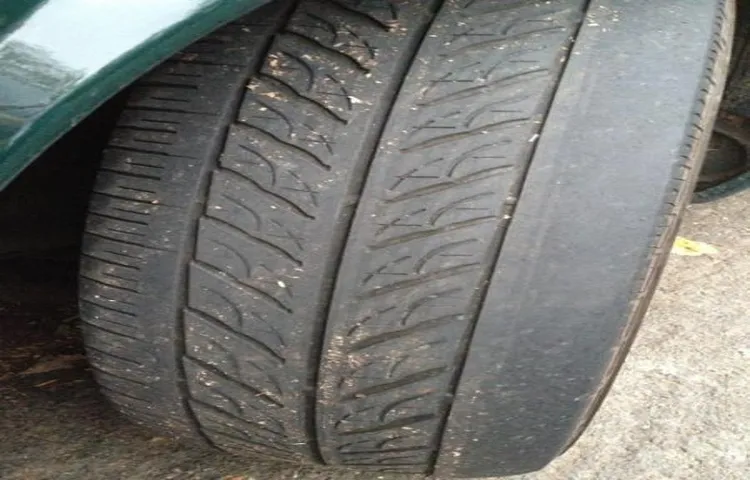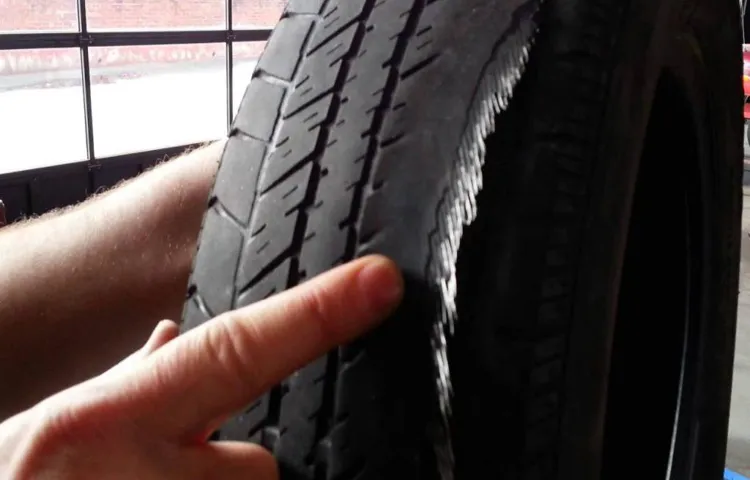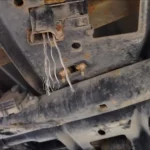Have you noticed that your right front tire is wearing on the outside? This can be frustrating, especially if you just got new tires not too long ago. But why is this happening? Well, there are a few reasons why your tire might be wearing unevenly, specifically on the outer edge. One of the most common causes is having improper wheel alignment.
When your wheels are not properly aligned, they can tilt inward or outward, putting uneven pressure on your tires. This can lead to uneven wear, particularly on the outer edges of your tires. Another cause could be having worn-out or damaged suspension parts.
If your shocks, struts, or ball joints are worn or damaged, they can cause your tire to lean outward, resulting in uneven wear. Lastly, it could simply be a matter of underinflation. When your tire is not properly inflated, it can cause the outer edges to wear down faster than the rest of the tire.
It’s important to address the issue as soon as possible, as uneven tire wear can compromise your safety on the road. Make sure to take your car to a trusted mechanic to have the problem diagnosed and fixed before it causes bigger issues down the line.
Table of Contents
Overview of Tire Wear
If you are wondering why your right front tire is wearing on the outside, there may be a few potential causes. One possible culprit is an alignment issue. If your vehicle’s wheels are not properly aligned, your tires will not make even contact with the road, which can cause uneven wear.
Additionally, if your tire pressure is too low, your tires can wear more quickly and unevenly, particularly on the outer edges. Another possibility is that your suspension system is in need of repair. Worn or damaged parts can cause misalignment and contribute to tire wear.
It’s also important to consider your driving habits- aggressive and fast driving can lead to excessive tire wear. If you’re unsure about the cause of your tire wear, it’s best to consult with a trusted mechanic to diagnose the issue and prevent further damage to your vehicle.
Definition and Causes of Tire Wear
Tire wear is a natural process that occurs as tires age and accumulate mileage. It is characterized by the gradual loss of tread depth, resulting in decreased traction, stability, and handling performance. There are several types of tire wear, including center wear, edge wear, cupping, and feathering, each with its unique causes and implications.
These causes include improper inflation, misalignment, overloading, lack of rotation, aggressive driving, and poor road conditions. Failure to address these issues can lead to premature tire failure, decreased fuel efficiency, and safety hazards. As a responsible vehicle owner, it’s vital to monitor tire wear regularly and take appropriate measures to prevent further damage and ensure maximum longevity of the tires.

Signs and Symptoms of Tire Wear
Tire wear is a natural but unavoidable occurrence that impacts the overall performance and safety of our vehicles. The more miles we put on our tires, the more they wear down, and eventually, they will need to be replaced. It’s important to pay attention to the signs and symptoms of tire wear to avoid any potential hazards on the road.
Some common indicators of tire wear include uneven wear patterns, low tread depth, cracks in the sidewall, and bulges or blisters on the tire’s surface. If you notice any of these signs, it’s best to have your tires inspected by a professional to ensure they are safe and to prevent any potential blowouts or loss of control while driving. Proper maintenance and regular inspections can help reduce the risk of tire wear and keep you and your vehicle safe on the road.
Possible Reasons for Outside Tire Wear
If you’re experiencing outside tire wear on your right front tire, there could be a few potential reasons. One of the most common causes is improper tire inflation. When tires are underinflated, the outer edges of the tire carry more weight than the center, causing excessive wear on the outer edges.
Another possible culprit is wheel misalignment, where the wheels aren’t properly positioned, causing the tires to wear unevenly. Additionally, worn suspension components like ball joints or tie rod ends can also contribute to outside tire wear. It’s important to have your vehicle inspected by a professional mechanic to determine the root cause of outside tire wear and make any necessary repairs to ensure your safety on the road.
Improper Wheel Alignment
Improper wheel alignment can cause tire wear on the outside edge, which can result in reduced tire life and poor ride quality. There could be several reasons for this type of tire wear, including worn steering components, improper tire inflation pressure, or a bent axle. Another common cause is misalignment, which can occur when there is too much or too little caster or camber, or when the toe is not set correctly.
Caster is the angle of the steering axis, while camber is the inward or outward tilt of the top of the tire, and toe is the angle of the tires relative to each other. When any of these angles are out of specification, it can cause uneven tire wear, particularly on the outer edge of the tire. To correct outside tire wear, it is important to have the wheel alignment checked and adjusted by a professional technician.
This will help ensure that your vehicle handles correctly, improves ride quality, and extends tire life. So, if you are experiencing outside tire wear, don’t hesitate; get your wheel alignment checked as soon as possible!
Underinflated Tires
Underinflated Tires If you ever notice that the outer edges of your tires are wearing out faster than the rest of the tire, it could be due to underinflated tires. When tires are underinflated, they tend to flatten out more, causing the outer edges to come in contact with the road. This increased friction leads to more wear and tear on the tire edges.
Besides, underinflated tires can also affect fuel efficiency, ride comfort, and overall handling. It is essential to monitor your tire pressure regularly and inflate them to the recommended level. The ideal tire pressure is usually printed on a label that is pasted inside the driver’s side door or in the vehicle’s owner’s manual.
Additionally, always check the tire pressure when the tires are cold and never overload the vehicle. Keeping your tires inflated to the recommended level not only ensures longer tire life, but it also promotes safer driving and helps reduce the risk of tire punctures or blowouts while on the road.
Worn or Damaged Suspension Parts
One possible reason for outside tire wear could be worn or damaged suspension parts. When you drive, your car’s suspension system absorbs all the bumps and jolts from the road, ensuring that you have a smooth ride. However, over time the components of the suspension system can wear out, leading to problems like tire wear.
If your suspension is out of alignment or if your shocks and struts are worn, your tires can wear unevenly, causing outside tire wear. In addition, worn suspension parts can also affect your car’s handling, making it harder to control and increasing the risk of an accident. To avoid these problems, it’s important to have your suspension system regularly inspected and maintained by a qualified mechanic.
By keeping your suspension in good condition, you can ensure that your car is safe to drive and that your tires last longer.
Steps to Fix Outside Tire Wear
If you’re wondering why your right front tire is wearing on the outside, there are several steps you can take to fix the issue. First, check the tire pressure and make sure it’s at the recommended level. Low tire pressure can cause uneven tire wear and lead to premature tire failure.
Next, check the alignment of your wheels. Misaligned wheels can cause excessive wear on the outside of your tires. If your tires are still wearing on the outside after checking the tire pressure and alignment, it may be time to replace your tires.
Look for tires with a tread pattern that promotes even wear and ensure they are installed correctly. Regular vehicle maintenance is crucial to maintaining your tires and extending their lifespan. By taking these steps, you can fix outside tire wear and potentially save yourself from costly tire replacements down the road.
Get a Wheel Alignment Check
If you’ve noticed that your tires are wearing unevenly on the outside, it’s important to get a wheel alignment check as soon as possible. Not only can uneven wear on your tires be dangerous for your vehicle, but it can also affect your car’s overall performance. The first step to fixing outside tire wear is to take your car to a trusted mechanic or tire shop to get an alignment check.
This process involves measuring and adjusting the angles of your tires to ensure they are perpendicular to the ground and parallel to each other. By doing this, you can improve your vehicle’s handling, increase fuel efficiency, and extend the life of your tires. So, the next time you notice uneven tire wear on the outside, don’t ignore it – get a wheel alignment check to keep your vehicle running smoothly and safely on the road!
Check and Adjust Tire Pressure
Checking and adjusting tire pressure is a crucial step to prevent outside tire wear and improve overall safety while driving. Proper tire pressure ensures that your vehicle’s weight is distributed evenly, which results in more balanced handling and lower fuel consumption. To check tire pressure, start by looking for the recommended pressure which can be found in the owner’s manual or on a sticker inside the driver’s door jamb.
Then, use a tire pressure gauge to measure the pressure of each tire. If the pressure is too high or too low, adjust it accordingly using an air compressor or a handheld tire pump. Remember to check your tire pressure regularly, especially before a long trip or in extreme weather conditions.
Keeping your tires properly inflated can save you time, money, and unnecessary wear and tear on your vehicle’s tires.
Check and Repair Suspension Components
If you’re experiencing outside tire wear, one possible cause could be an issue with your suspension components. In order to check and repair these components, follow these steps. First, inspect your tires for any signs of wear and take note of which areas are affected.
Then, have a professional mechanic inspect the suspension system for any signs of damage or wear. This may involve checking the shocks, struts, ball joints, and tie rod ends, among other components. If any issues are identified, the mechanic can recommend the appropriate repairs or replacements.
By addressing suspension issues promptly, you can prevent unnecessary wear and tear on your tires and keep your vehicle running smoothly.
Conclusion
Well, my dear driver, it seems that your right front tire is eager to explore the world beyond the confines of your vehicle. Perhaps it has dreams of rolling down the hills and valleys, basking in the sun, and feeling the wind in its rubber threads. Or, it could be that your suspension system has misaligned, causing it to carry more weight on the outside edge of the tire.
Whatever the reason may be, it’s important to get it checked out by a professional before your tire goes rogue and escapes on its own adventure.”
FAQs
What are the common reasons for wearing of tires on the outside?
The most common reasons can be misaligned wheels, worn-out suspension components, incorrect tire pressure, or poor driving habits.
How can I know if my tires are wearing out on the outside?
You can easily tell by inspecting the tires regularly. Check for the depth of the tread on the outer edges of the tires, and compare it with the middle part of the tires. Uneven wear indicates the tires are wearing on the outside.
Can I still drive on my tires if they are wearing on the outside?
It depends on the severity of the wear. If there is only minor wear, you can still drive on them, but with caution. However, if the wear is severe, you should replace the tire as soon as possible to avoid further damage.
Can tire rotation prevent uneven wear on the outside of tires?
Yes, tire rotation can help to evenly distribute the wear on the tires, including the outer edges. It is recommended to rotate tires every 5,000 to 7,000 miles.
How often should I check the tire pressure to prevent wearing on the outside?
You should check tire pressure at least once a month or before any long road trips. Proper tire pressure can prevent uneven wear on the outside and extend the life of the tire.
What should I do if my tires are wearing on the outside but they are still new?
It could be a manufacturing defect, and you should contact the tire manufacturer to check the warranty or get a replacement.
Why is it dangerous to drive on tires that are wearing on the outside?
Worn-out tires reduce the grip on the road, which can lead to accidents, especially in wet or slippery road conditions. It is crucial to maintain the tires properly to ensure your safety on the road.



